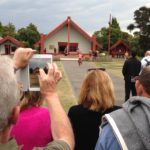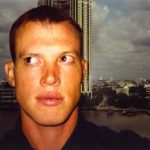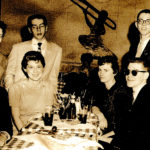Bill Dalton founded Moon Publications in a youth hostel in Queensland, Australia, in 1973, with the publication of his groundbreaking Indonesia Handbook. The Moon Handbooks series has since become known for its award-winning, well-written and exceptionally informative guides. Though his travels have taken him to 81 countries around the world, Dalton has always had a special interest in Southeast Asia. During the past 26 years, he has explored over 100 of Indonesia’s 17,000 islands, visiting the country over 50 times and amassing a total of six years in the islands. He’s hitched rides on oil company planes, climbed a dozen volcanoes, ridden on top of buses the length of Sumatra, and trekked through mosquito-infested swamps to live amongst aborigine tribes. He is considered the foremost travel expert on Indonesia.
How did you get started traveling?
Travel got into my blood very early. When I was growing up in Wellesley, Massachusetts, just six or seven years old, my Dad used to come into my room in the middle of the night, wake me up and tell me to get dressed. We then climbed into the family car and headed out to California, Florida, or god knows where else — sometimes with me driving on his lap. The next morning, after he sobered up, we would find ourselves blinking in the harsh daylight of Times Square or the Maine coastline, hundreds of miles from home. When he started taking my younger brother along on these “night trips” too, my mother threatened to divorce him, so he stopped (she also began taking away the car keys on his drinking nights). These nocturnal flights were the first time I ever experienced the ecstasy of the open road, and they never left me. I ended up traveling for twelve years through 67 countries, as free as a leaf in the wind. In a sense, I’ve never gotten off the road.
How did you get started writing?
Handing in a short story in the sixth grade was the first time I suspected that I had writing ability. The teacher was so threatened by my story that she gave me a failing grade, took me aside after class and asked me, “Do you agree that I can write better than you?” From that day on I started reading and writing more.
What do you consider your first “break” as a travel writer?
One afternoon in 1973 in a youth hostel in northern Australia, I was typing out some tips on travel through Indonesia for a couple of German guys. A crusty old New Zealand journalist named Noel came up and said, “You shouldn’t just give that information away, you should sell it!” He told me about an art festival that was to take place in Nimbin, New South Wales, the following week. This was Australia’s Woodstock. I had met some girls at the Cairns Public Library and they let me use the mimeograph copier one evening when the library was closed. I printed out 800 copies of my tips, calling it “A Traveler’s Notes: Indonesia,” stapled the three sheets together, and the next day got a ride on the back of a motorcycle down to Nimbin. On the first day of the festival I set up shop on a blanket on the town’s main street and sold my travel notes for 50 cents apiece. I made $150 the first day and sold out completely by the 3rd day. I knew I was onto something. You could say that this was my first big break because this modest typewritten publication eventually grew into a publishing organization with over 70 titles distributed in 30 countries around the world. I sold all my remaining interests in Moon Publications in 1999, though the books live on under a series called “Moon Travel Handbooks.”
As a traveler and fact/story gatherer, what is your biggest challenge on the road?
Since I’m a travel specialist on the largest archipelago in the world, made up of over 17,000 islands, my biggest challenge has always been to cover as many worthwhile destinations as possible in an accurate, complete and fair manner. I have only ever been able to visit about 40% of Indonesia’s tourist destinations first hand. But even 40% is a gargantuan task and obviously what has always been difficult is maintaining the stamina and resourcefulness to persevere on the ground for months at a time researching a new edition.
What is your biggest challenge in the writing process?
Since I cannot possibly visit every place I write about, I have to use other means of obtaining information. I interview other travelers, hotel and restaurant owners, Indonesian tourism officials, as well as glean information from reader’s letters, guidebooks, reference books, videos, brochures, timetables. Like an insatiable vacuum cleaner, I just grab anything written that’s not nailed down. It’s a never-ending job. I remember once spending four whole days in my underpants in an air- conditioned hotel room on Kuta Beach checking information on the telephone for a new edition of “Bali Handbook.”
What is your biggest challenge from a business standpoint?
When my relationship with Moon changed from that of being an owner to that of being a writer, my biggest challenge was to goad our distributors and in-house sales and publicity departments to get my guidebooks into as many retail and chain bookstores as possible and distributed in as many countries as possible. An author is never satisfied with the way his or her book is distributed.
Do you do other work to make ends meet? If so, what kind of work?
For seven years I led up-market adventure tours to West New Guinea (now called Papua), Komodo Island and central Borneo until a group of New Yorkers I led in 1999 cured me of ever wanting to lead a tour again in my life.
What travel authors or books might you recommend and/or have influenced you?
Believe it or not, two books that are not even travel books per se had a deep and lasting influence on me. The main character (I forgot his name) in Somerset Maugham’s The Razor’s Edge I held up as a model of the ideal traveler. Another obscure book called A Surgeon’s Log (I forget the author), describing a pre-war sea journey around the world, first instilled in me a love of exotic travel. Much later on in the early 1970s, when we were both starting up our companies, Tony Wheeler of Lonely Planet sent me a copy of Fussell’s Abroad , one of the most beautifully timed and well- intentioned gifts I’ve ever received. As for learning about the art of printing and publishing, an early book that taught me a lot was Printing It .
What advice would you give to someone who is considering going into travel writing?
This is a complicated question because there are two kinds of travel writing — writing a travel guidebook and writing travelogue (or travel narrative, or whatever you want to call it). Both are sub-specialties of the travel-writing genre. In guidebook writing, because of the ferocity of the competition and the paucity of the rewards, I would recommend not taking up this kind of writing if you can possibly help it. As for real expository travel writing, the finest of which emulates great literature, just go for it because if you’re a natural born writer you will never rest until you have at least made the attempt.
What is the biggest reward of life as a travel writer?
To be an anonymous free agent. I like being a well-informed and experienced observer and evaluator of travel destinations and services without anyone being aware of what I’m doing. Several times I’ve taken extensive notes while eavesdropping on travelers who are exchanging travel impressions and information as they sat around an adjacent table in a restaurant. I also love learning about weird subjects that I would not ordinarily ever care about or pursue. When you write travel, you write about every topic under the sun — history, religion, ethnography, music, the arts, biology, economics — you name it. It’s a profession the pursuit of which makes for a well-rounded education.





